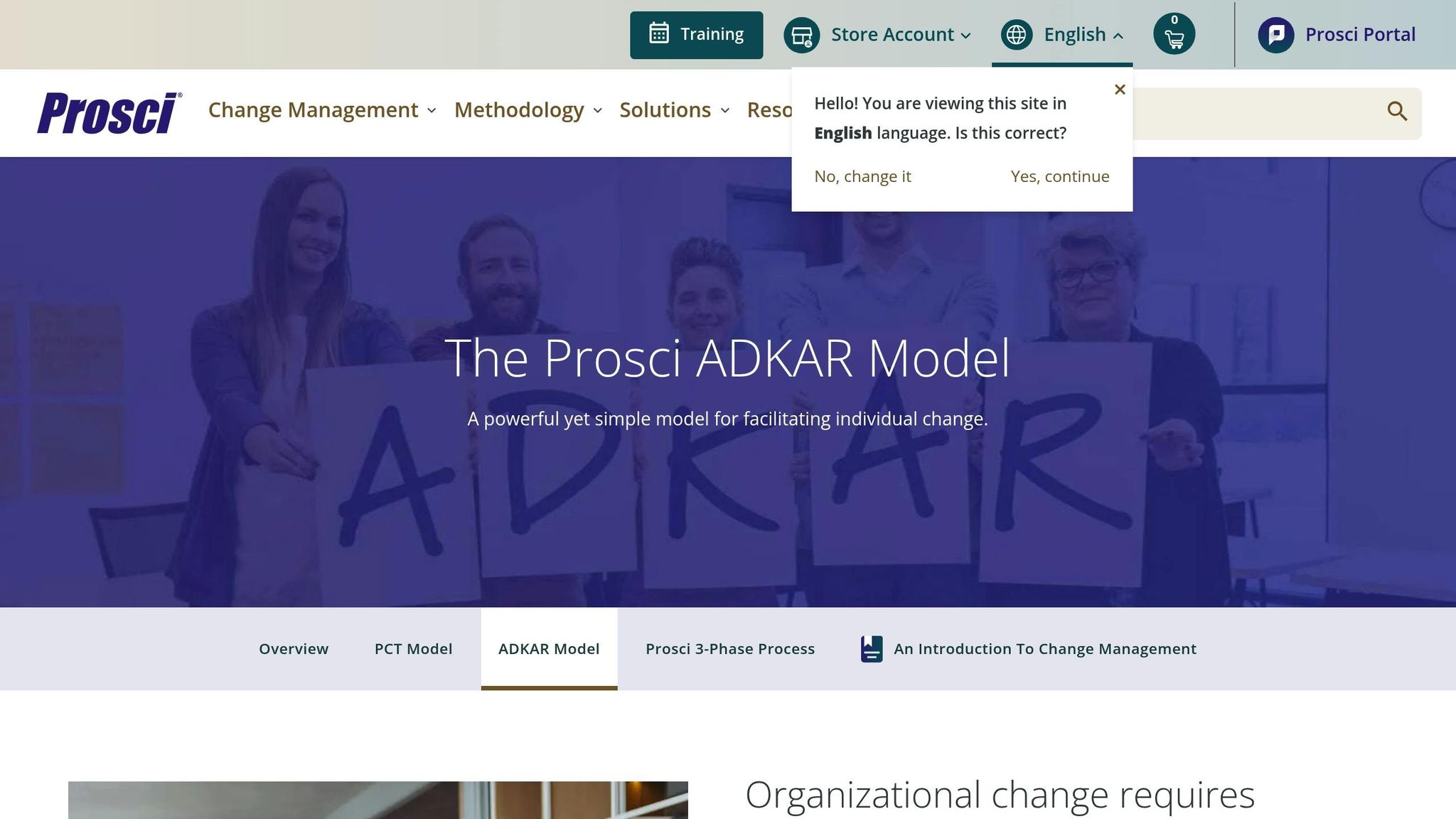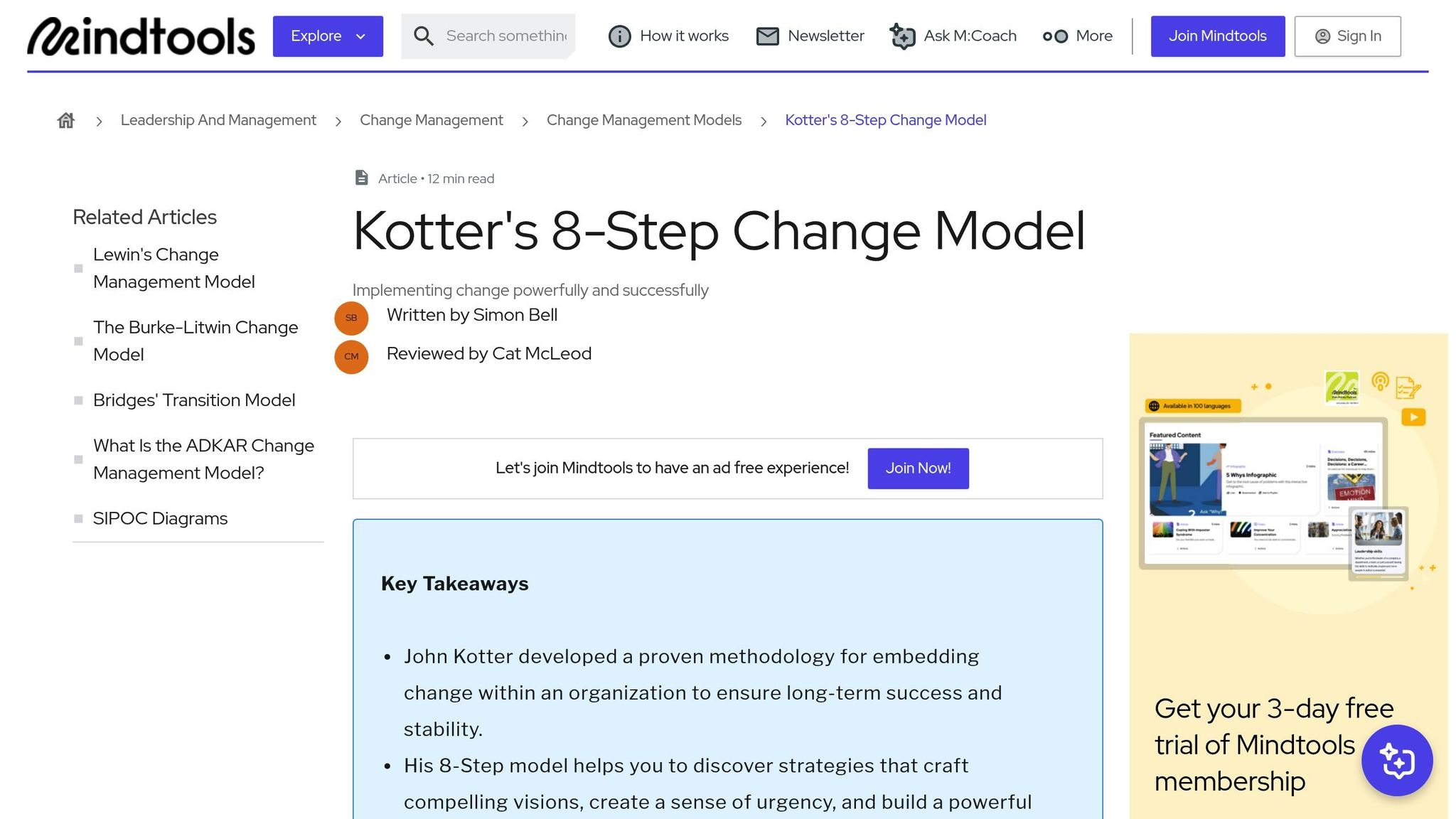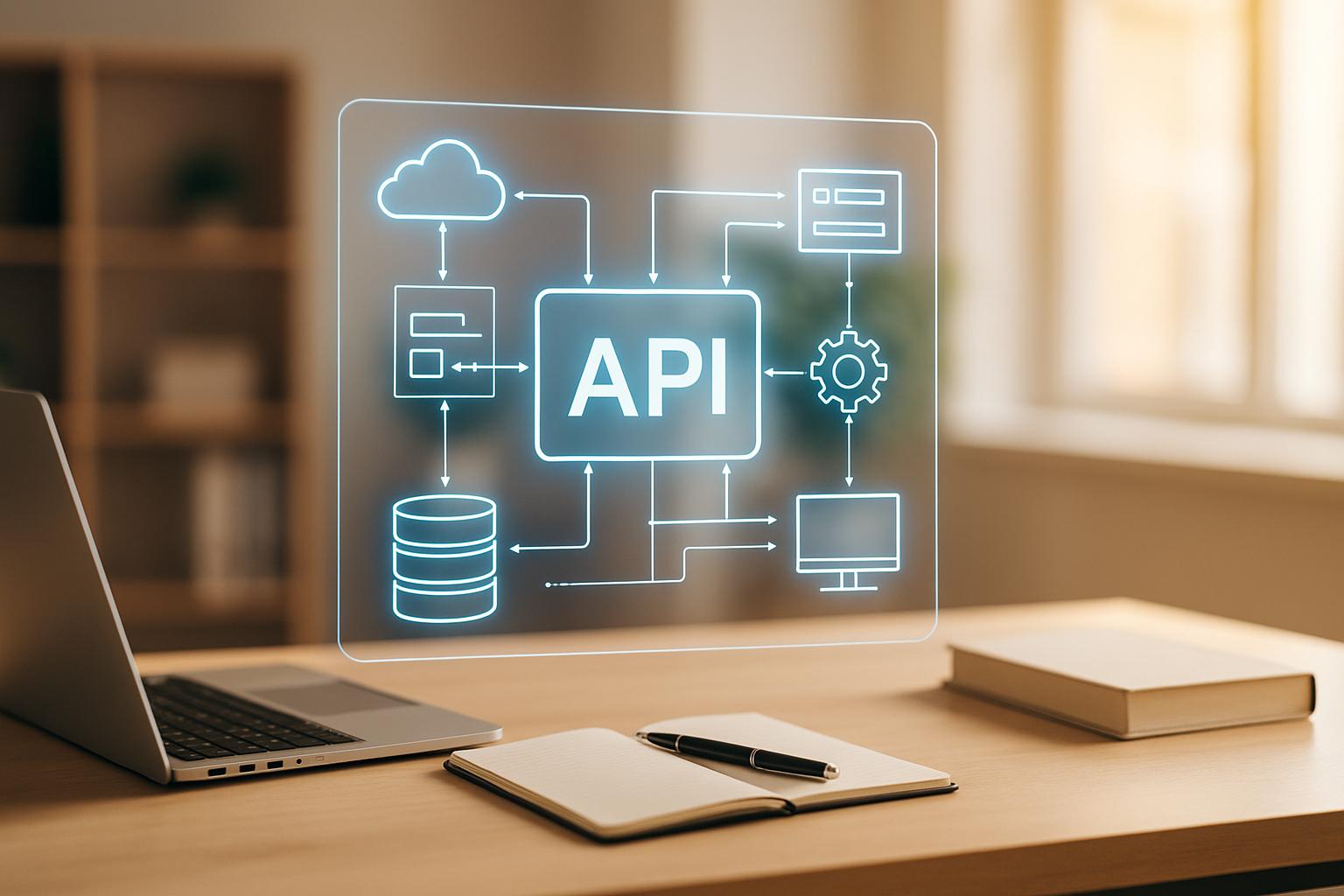Feedback is the backbone of successful change management. It helps organizations align leadership goals with execution, uncover challenges, and make real-time adjustments. Here’s why feedback matters and how to use it effectively:
-
Key Benefits:
- Reduces resistance by giving employees a voice.
- Speeds up adoption by identifying gaps early.
- Builds trust and alignment across teams.
- Enables quick adjustments during implementation.
-
Core Goals:
- Informed decision-making with actionable insights.
- Improved collaboration through open communication.
- Continuous process improvement by addressing inefficiencies.
-
How to Build Feedback Systems:
- Set clear, measurable objectives.
- Use methods like surveys, focus groups, and digital tools.
- Act quickly on feedback to maintain trust.
-
Feedback in Change Models:
- In the ADKAR framework and Kotter’s 8 Steps, feedback is essential at every stage - from identifying resistance to sustaining change.
-
Digital Tools:
- Use AI-powered tools for real-time analysis.
- Integrate feedback with systems like CRM or HR platforms.
Takeaway: Effective feedback systems can boost change success rates by 30–50%. Act on feedback promptly, ensure confidentiality, and use the right tools to drive meaningful change.
What Are Feedback Systems In Place To Do? - BusinessGuide360.com

Building Strong Feedback Systems
Creating an effective feedback system requires a structured approach that ensures open communication and actionable outcomes.
Designing Your Feedback System
The foundation of a strong feedback system lies in setting clear goals and a plan to achieve them.
- Set Clear Objectives: Define measurable goals like employee satisfaction, adoption rates, or compliance levels. Establish baseline metrics to track progress effectively.
- Create an Implementation Plan: Develop a framework for gathering, analyzing, and acting on feedback. This could include:
- Regular check-ins with relevant stakeholders
- Clear deadlines for addressing feedback
- Escalation procedures for urgent matters
- Consistent documentation to identify recurring patterns
- Analyze and Act: Use analytics to turn feedback into actionable steps by identifying trends and prioritizing pressing issues.
Once the system is in place, the next step is to choose the right methods for collecting feedback.
Choosing Feedback Methods
The method you choose should align with your goals and the type of insights you need. Here's a quick comparison of popular feedback methods:
| Feedback Method | Best Used For | Key Benefits | Considerations |
|---|---|---|---|
| Anonymous Surveys | Large-scale feedback, sensitive topics | Encourages honest responses; high participation | May lack detailed insights |
| Focus Groups | In-depth discussions, brainstorming | Provides rich, qualitative data | Time-intensive; smaller participant pool |
| One-on-One Interviews | Leadership feedback, detailed insights | Builds trust; allows for deep exploration | Resource-heavy; scheduling can be tricky |
| Digital Feedback Tools | Real-time and remote team input | Immediate insights; strong data analytics | Requires team adoption of the technology |
Encouraging Open and Honest Feedback
Building trust is key to fostering a culture where feedback flows freely. Research indicates that environments with high psychological safety see a 32% increase in actionable feedback.
Here’s how to create that trust:
- Respond Promptly: Act on feedback quickly and visibly to show you value input.
- Ensure Confidentiality: Use secure platforms and establish clear privacy guidelines to protect contributors.
- Train Managers: Equip leaders with the skills to handle feedback constructively and turn it into meaningful actions.
- Recognize Contributions: Publicly appreciate teams and individuals who provide valuable insights to encourage ongoing participation.
Feedback in Change Models
Feedback in ADKAR Framework

The ADKAR model incorporates feedback as a critical tool at every phase of the change process. Each stage focuses on gathering specific insights to ensure smooth progress and address challenges effectively.
| ADKAR Stage | Feedback Focus | Key Actions |
|---|---|---|
| Awareness | Understanding the need for change | Pulse surveys, team discussions |
| Desire | Gauging motivation levels | One-on-one interviews, anonymous feedback |
| Knowledge | Assessing training effectiveness | Skills assessments, learning analytics |
| Ability | Identifying implementation challenges | Performance metrics, support requests |
| Reinforcement | Ensuring sustainability | Compliance audits, monitoring adoption rates |
For instance, during the Knowledge phase, feedback might reveal gaps in understanding, prompting the need for additional training programs or resources.
Feedback isn't just limited to ADKAR - it plays a similarly vital role in Kotter's change model.
Feedback in Kotter's 8 Steps

Kotter's 8 Steps emphasize feedback as a guiding force throughout the change journey:
-
Creating a Sense of Urgency
Feedback ensures employees understand the need for change by highlighting market trends, competitive threats, or inefficiencies within the organization. -
Building the Guiding Coalition
Trusted change champions gather feedback from team members, identifying resistance points and areas where additional support is needed. -
Developing and Communicating the Vision
Regular feedback helps refine the vision and communication strategies. Surveys and engagement metrics reveal whether the message resonates with stakeholders. -
Empowering Action and Generating Wins
Feedback identifies obstacles, resource gaps, and opportunities to celebrate quick wins. These insights help maintain momentum and address areas needing improvement. -
Sustaining Change
Continuous feedback loops allow organizations to track progress, measure adoption rates, and adjust strategies as needed. Studies show that organizations with robust feedback systems are better equipped to sustain long-term change.
To make feedback truly impactful in these models, organizations should:
- Leverage digital tools to simplify feedback collection and analysis.
- Encourage open communication, ensuring feedback flows both upward and downward.
- Act quickly on critical feedback to maintain trust and momentum.
- Share examples of how feedback has influenced decisions to reinforce its importance.
For large-scale transformations, expert guidance can be invaluable. The Top Consulting Firms Directory (https://allconsultingfirms.com) offers connections to firms specializing in feedback-driven change management.
sbb-itb-97f6a47
Digital Tools for Feedback Management
Modern feedback tools have revolutionized how organizations gather and act on insights, offering real-time data to guide effective decision-making. These tools simplify the process of collecting feedback and turning it into actionable strategies, helping leaders tackle challenges during times of organizational change. Plus, they integrate smoothly with existing business systems, making them even more valuable.
Essential Feedback Platform Tools
Feedback platforms are designed to create a seamless system for gathering and analyzing input. They can automate tasks like sending surveys, track sentiment in real time, and generate tailored reports that help leaders make informed decisions. Here’s a breakdown of the main categories of feedback tools:
| Feedback Tool Category | Key Features | Best For |
|---|---|---|
| Survey Platforms | Customizable templates, scheduled surveys, real-time analytics | Gathering structured feedback |
| Pulse Feedback Tools | Quick check-ins, mobile-friendly access, trend tracking | Monitoring ongoing sentiment |
| AI-Powered Analytics | Natural language processing, sentiment analysis, pattern detection | Handling large sets of unstructured feedback |
| Integration Platforms | API connections, data sync, cross-system reporting | Linking feedback to other business systems |
AI Applications in Feedback Analysis
Artificial intelligence has completely changed the way organizations process feedback. AI tools can:
- Quickly analyze large volumes of feedback to identify recurring themes
- Track shifts in sentiment to spot early signs of resistance
- Use historical data to predict potential challenges
- Extract actionable insights from unstructured feedback, like open-ended survey responses
These AI-driven features allow leaders to focus on the areas that need attention most, helping them adapt strategies to meet evolving needs. On top of that, these tools can seamlessly integrate feedback data into broader business systems.
Connecting Feedback with Business Systems
When feedback platforms connect to systems like CRM, HR tools, or project management software, they create a holistic view of how changes impact an organization. For example:
- CRM Systems: Link customer feedback with internal change initiatives to align strategies.
- HR Platforms: Monitor employee engagement and performance during transitions.
- Project Management Tools: Adjust implementation plans based on real-time feedback.
For businesses looking to integrate these tools, resources like the Top Consulting Firms Directory offer expert advice.
It’s also essential to prioritize data privacy and security when using these platforms. Most modern tools include features like end-to-end encryption, role-based access, anonymous feedback options, and automated compliance checks to ensure feedback is handled ethically and securely.
Feedback Across Company Levels
Fine-tuning feedback systems across all levels of an organization is crucial for driving meaningful change. Each group within the company needs tailored approaches that align with their specific roles, while still supporting the overall objectives of the change initiative.
Executive Team Feedback Methods
For senior leaders, feedback must be focused, data-driven, and directly tied to the company’s strategic goals. This group benefits most from high-level metrics and structured methods that emphasize strategic alignment.
| Feedback Method | Purpose | Key Features |
|---|---|---|
| Executive Dashboards | Strategic Overview | Real-time KPIs, trend analysis, impact metrics |
| Leadership Roundtables | Strategic Discussion | Quarterly sessions, cross-functional insights |
| 360-Degree Feedback | Leadership Assessment | Comprehensive evaluation, blind spot identification |
When presenting feedback to executives, keep it concise and actionable. Use benchmarking data to provide context and ensure regular review cycles to track progress and refine strategies.
Unlike executives, employees require feedback that directly addresses their day-to-day operations and challenges.
Employee Feedback Strategies
While leadership teams focus on overarching strategies, employees need feedback systems that are practical and encourage open communication. Creating an environment where employees feel safe to share honest input is critical. At the same time, feedback channels should offer clear paths for action.
Change champions play a pivotal role in this process by:
- Gathering real-time insights from employees.
- Identifying and interpreting concerns.
- Relaying feedback to decision-makers in leadership.
- Following up visibly to build trust and accountability.
Small group discussions and post-training sessions are particularly effective for gathering immediate, actionable feedback and addressing any uncertainties about change initiatives.
Multi-Location Feedback Management
For organizations operating across multiple locations, maintaining consistent feedback practices while accommodating regional differences can be a challenge. Success lies in balancing standardized processes with the flexibility to adapt to local needs.
| Aspect | Implementation Strategy |
|---|---|
| Digital Tools | Cloud-based platforms with multi-language support |
| Local Compliance | Adherence to region-specific data privacy rules |
| Cultural Adaptation | Tailored feedback methods to respect local norms |
| Time Zones | Asynchronous feedback options for global teams |
To ensure effectiveness, organizations should standardize the core elements of their feedback systems while allowing room for regional customization. Virtual town halls and location-specific feedback sessions are excellent ways to address the unique challenges faced by individual offices, all while keeping the broader organizational goals in focus.
Ultimately, effective feedback systems need ongoing evaluation and refinement. Regular reviews help ensure these systems continue to meet the needs of employees and leaders alike, supporting the overall objectives of change management initiatives.
Next Steps
Main Points Review
Feedback systems are a powerful tool for driving change, often increasing success rates in initiatives by 30–50%.
Here are some key components for effective feedback systems:
| Component | Focus Area | Measurable Impact |
|---|---|---|
| Active Listening | Employee experience channels | Engagement rates and sentiment scores |
| Compliance Monitoring | Process adoption tracking | Implementation success metrics |
| Analytics Framework | Measuring change effectiveness | ROI and business impact data |
To make feedback truly effective, organizations should act on input quickly - ideally within 5 business days. This quick turnaround keeps the momentum alive and shows employees that their voices matter.
With these foundational elements in place, the next step is to bring in expert support to turn feedback into meaningful, long-term change.
Finding Change Management Help
Once the basics of a feedback system are established, partnering with experts can help speed up the process and ensure success. The Top Consulting Firms Directory is a great resource for finding professionals who can design and implement these systems effectively.
Look for partners who offer:
- Expertise in digital feedback platforms with real-time analytics
- A history of implementing feedback systems across various organizational levels
- Proven success in managing change initiatives
- The ability to integrate feedback mechanisms with existing business tools
To ensure you're on the right track, consider creating a feedback effectiveness index. This index should combine metrics like participation rates (aiming for 70%+ engagement), response times, and quality scores that assess the actionability of collected feedback.
FAQs
How can organizations protect the confidentiality and security of feedback during change management?
To keep feedback confidential and secure during change management, it's crucial to put strong data protection practices in place. Start by using secure digital tools to gather and store feedback, ensuring access is restricted to authorized personnel only. Whenever feasible, anonymize responses to safeguard individual identities and promote genuine, honest input.
It's also important to routinely evaluate and update your security measures to tackle any potential risks. By focusing on confidentiality and securing data, you can strengthen employee trust and create an environment where open and constructive feedback thrives.
What are the best practices for integrating digital feedback tools with business systems like CRM or HR platforms?
Integrating digital feedback tools with platforms like CRM or HR systems can make communication and decision-making much smoother. To get it right, here are some practical tips:
- Pick tools that work well with your systems: Look for feedback tools that come with built-in integrations or APIs that align with what you're already using.
- Keep data security a priority: Make sure the tool adheres to data privacy laws and uses encryption to protect sensitive information.
- Automate where you can: Set up workflows to automatically send feedback to the right teams or departments, cutting down on manual tasks.
- Run a test first: Before a full rollout, do a pilot test to catch technical glitches and gather input from users.
These steps can help streamline your feedback process and make managing change a lot more effective.
How can businesses ensure consistent feedback systems across multiple locations while respecting regional differences?
To keep feedback systems consistent across various locations, businesses should create a clear framework that defines key processes, tools, and goals. This approach ensures every location operates under the same guidelines while still leaving space for regional adjustments.
Equally important is tailoring the system to fit local norms and preferences. This might involve addressing differences in communication styles, languages, or even compliance with local regulations. By regularly analyzing feedback from each region, businesses can spot trends and make necessary tweaks, keeping the system efficient and relevant for all.


